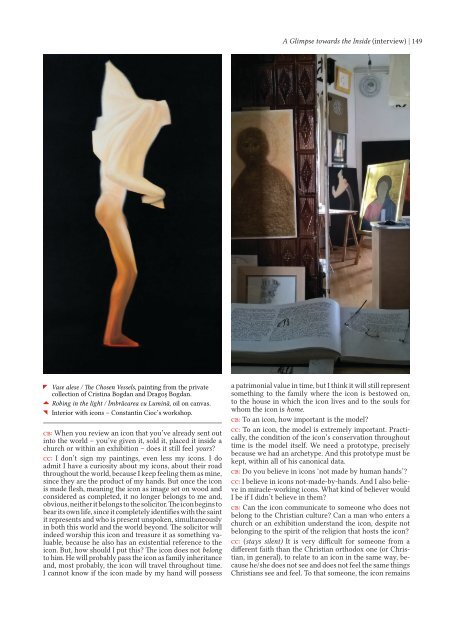Museikon_1_2017
Create successful ePaper yourself
Turn your PDF publications into a flip-book with our unique Google optimized e-Paper software.
A Glimpse towards the Inside (interview) | 149<br />
Vase alese / The Chosen Vessels, painting from the private<br />
collection of Cristina Bogdan and Dragoş Bogdan.<br />
Robing in the light / Îmbrăcarea cu Lumină, oil on canvas.<br />
Interior with icons – Constantin Cioc’s workshop.<br />
cb: When you review an icon that you’ve already sent out<br />
into the world – you’ve given it, sold it, placed it inside a<br />
church or within an exhibition – does it still feel yours?<br />
cc: I don’t sign my paintings, even less my icons. I do<br />
admit I have a curiosity about my icons, about their road<br />
throughout the world, because I keep feeling them as mine,<br />
since they are the product of my hands. But once the icon<br />
is made flesh, meaning the icon as image set on wood and<br />
considered as completed, it no longer belongs to me and,<br />
obvious, neither it belongs to the solicitor. The icon begins to<br />
bear its own life, since it completely identifies with the saint<br />
it represents and who is present unspoken, simultaneously<br />
in both this world and the world beyond. The solicitor will<br />
indeed worship this icon and treasure it as something valuable,<br />
because he also has an existential reference to the<br />
icon. But, how should I put this? The icon does not belong<br />
to him. He will probably pass the icon as family inheritance<br />
and, most probably, the icon will travel throughout time.<br />
I cannot know if the icon made by my hand will possess<br />
a patrimonial value in time, but I think it will still represent<br />
something to the family where the icon is bestowed on,<br />
to the house in which the icon lives and to the souls for<br />
whom the icon is home.<br />
cb: To an icon, how important is the model?<br />
cc: To an icon, the model is extremely important. Practically,<br />
the condition of the icon’s conservation throughout<br />
time is the model itself. We need a prototype, precisely<br />
because we had an archetype. And this prototype must be<br />
kept, within all of his canonical data.<br />
cb: Do you believe in icons ‘not made by human hands’?<br />
cc: I believe in icons not-made-by-hands. And I also believe<br />
in miracle-working icons. What kind of believer would<br />
I be if I didn’t believe in them?<br />
cb: Can the icon communicate to someone who does not<br />
belong to the Christian culture? Can a man who enters a<br />
church or an exhibition understand the icon, despite not<br />
belonging to the spirit of the religion that hosts the icon?<br />
cc: (stays silent) It is very difficult for someone from a<br />
different faith than the Christian orthodox one (or Christian,<br />
in general), to relate to an icon in the same way, because<br />
he/she does not see and does not feel the same things<br />
Christians see and feel. To that someone, the icon remains


